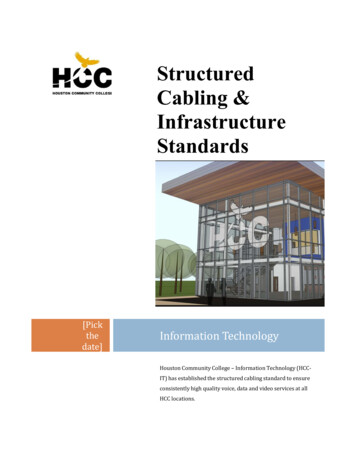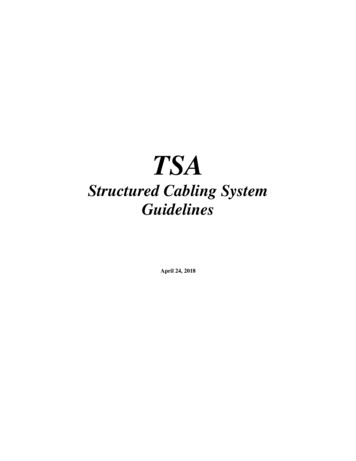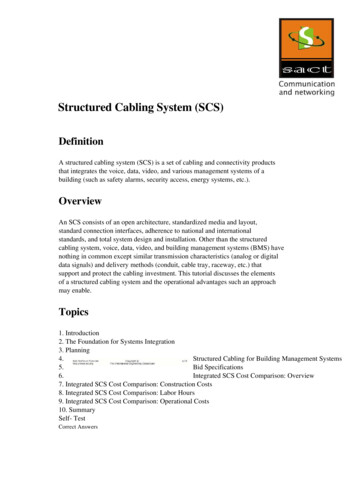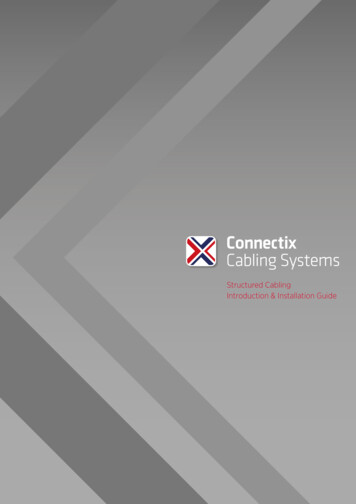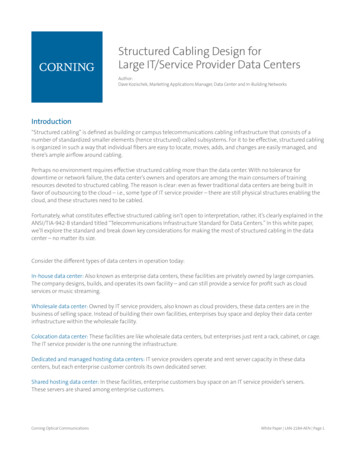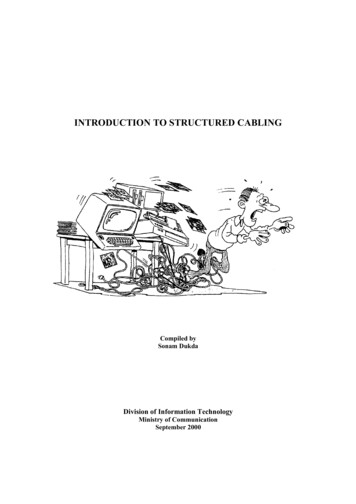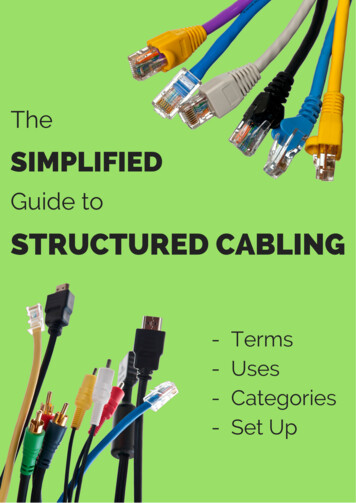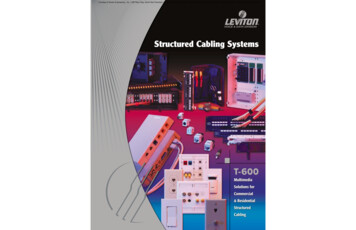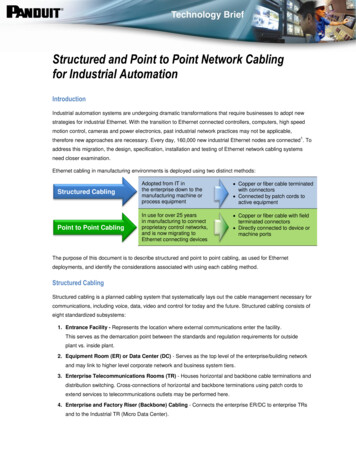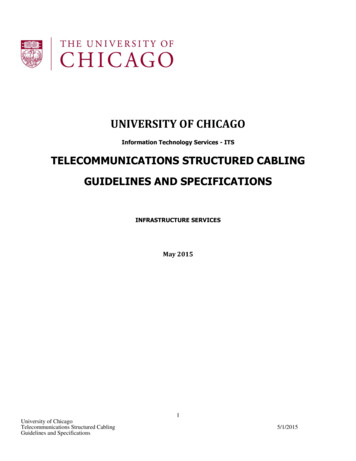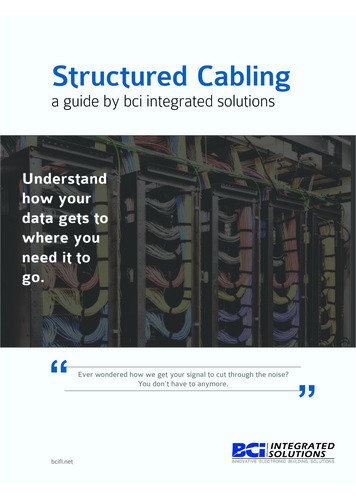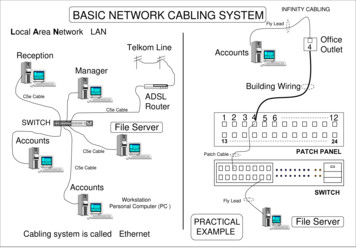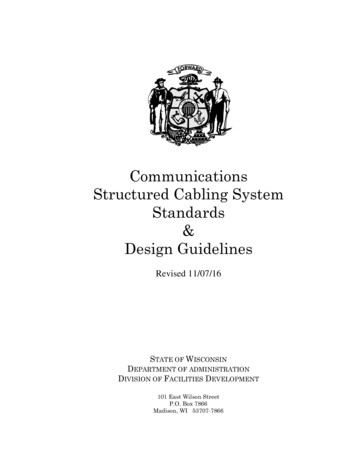
Transcription
CommunicationsStructured Cabling SystemStandards&Design GuidelinesRevised 11/07/16STATE OF WISCONSINDEPARTMENT OF ADMINISTRATIONDIVISION OF FACILITIES DEVELOPMENT101 East Wilson StreetP.O. Box 7866Madison, WI 53707-7866
Page Intentionally Blank
Communications Structured Cabling SystemStandards & Design GuidelinesTable of ContentsPageCONTENTI. INTRODUCTION 1II.A/E RESPONSIBILITIES 2III.BID DOCUMENTS 2A. General 2B. Coordination With Other Divisions 2C. Integration with Other Systems 2D. Drawings – General Requirements 3E. Specifications – General Requirements 6F. Preliminary (35%) Review Stage Requirements 6G. Final Review Stage Requirements 7IV.STRUCTURED CABLING 7A. General 7B. Cable Types 8C. Cable Classification 8D. Inter-Building Backbone Cabling (Outside Cable Plant ) 9E. Intra-Building Copper Backbone Cabling 10F. Backbone Fiber Optic Cable: 11G. Horizontal Permanent Link 12H. Modular Plug for Access Point and Security Cabling 16I.Cross-Connect Jumpers and Patch Cords: 16J.Wide-band Video Distribution System 17K. Transmission System Conversion 18L. Contractor Qualifications 18M.Warranties 18V.EQUIPMENT ROOMS AND OTHER SPACES 18A. Room Types and Hierarchy 18B. Equipment Room Provisioning 19C. Room-specific Requirements 20VI.CABLE PATHWAYS 22A. Inter-building Backbone Pathways 22B. Direct-buried Cable 24C. Intra-building Pathways - Pull and Junction Boxes 24D. Intra-Building Pathways 25E. Horizontal Pathways 26F. Work Area 27G. Equipment Outlet (EO) 28H. Special Conditions and Applications 29VII. GROUNDING AND BONDING 29A. General 29B. Topology and Components 29C. Grounding of Equipment and Cable Considerations 31VIII.FIRE STOPPING 31A. General 31IX.PROJECT PLANNING 32X.INSTALLATION PRACTICES – STRUCTURED CABLING 32XI.LABELING 32XII. TESTING AND DOCUMENTATION 32XIII.DRAWING SYMBOLS 32APPENDICESI. ACRONYMS AND GLOSSARY 1II.STRUCTURED CABLING – DETAILS 1III.CABLE CLASSIFICATION TABLES 1A. Power Limited Cable: 1B. Limited Use Cables: 1C. General Purpose Cable: 1TOCPage i
Communications [metallic] Cable: 2Fiber Optic Cable: 2IV.CODES AND STANDARDS 1A. General 1B. Purpose 1C. Standards Organizations 1D. Building Code and Standards Producers 2E. Fire Codes 2F. Communication Codes and Standards 2G. TIA/EIA Engineering Standards and Publications 2H. Enforcement of Codes and Standards 3D.E.TOCPage ii
I.INTRODUCTIONThis manual establishes standards and guidelines for the design, construction and renovation of State ofWisconsin facilities. These standards and guidelines were developed from past Division of FacilitiesDevelopment (DFD) and agency experience with the operation and maintenance of State communicationssystems.The purpose of this document is to provide A/E firms and agency personnel with the information necessaryto design and specify a Structured Cabling System for DFD projects supporting a wide range ofcommunications systems. These guidelines concentrate on new building environments and existingbuildings under consideration for renovation of wiring plants. Existing facilities can also benefit byfollowing these guidelines when adding new applications to their existing wiring plants. The document canalso be used by agencies in developing a usable program statement (scope of work) for new projects.The focus of these documents is Division 27 work. References to other division of work are also included,however. The Division 27 designer should work closely with designers of other divisions of work –especially Division 26 - to ensure an integrated design that provides adequate equipment space, pathways,electrical power and lighting, and mechanical system support for the project.These guidelines define minimum requirements but allow for customization to meet specific requirementsfor each project. The resulting design should provide full functionality for the agencies current applicationsand provide the flexibility that will enhance future opportunities to meet future requirements in thecategories of voice, data, audiovisual and security systems.It should be noted that various State agencies maintain their own site-specific guidelines. The consultantshall check with the agency to determine where such guidelines exist that would apply to their scope ofwork. Agency guidelines shall supplement these DFD guidelines and the DFD master specifications.Conflicts between the guidelines shall be discussed with DFD and the agency to achieve resolution.Deviations from these guidelines are not permitted without approval from DFD.It should also be understood that there likely are situations requiring special design features not covered inthese guidelines. It is the responsibility of the consultant or agency personnel to discuss such issues withDFD before incorporating them into the documents for construction.The requirements of these guidelines may exceed what is required by applicable code. In no case is itintended that these guidelines allow designs not conforming to applicable codes.These guidelines remain under continuous scrutiny and change. Changes will result from the overalladvancement of technology and industry practices, from further experience in State facilities, and from thecomments of consultants, contractors, and agency personnel. Consultants and agency personnel shouldroutinely review these guidelines and the DFD master specifications for Division 27 and related divisionsof work as they apply to each particular project. For the latest version of this document and other DFD master specification documents, from the DFDWebsite, click on “Document Library & Master Specs", then select the link “Master Specifications /Design Guidelines”. On that page, select the link “27 - Communications”.Compliance with Laws and Regulations: Readers of this document should review the documents in theDFD Master Specifications, Division 1, General Conditions, General Requirements, and referencedstatutes, codes, and zoning rules.Codes and Standards (plus update bulletins and errata) applicable to Communications Structured Cablinginclude:General ANSI/IEEE C2 - National Electrical Safety Code SPS Chapter 316 – Wisconsin Dept. of Safety and Professional Services Electrical CodeStructured Cabling and Infrastructure TIA-568.0-D, -568.1-D, -568-C.2, -569-C, -606-B and TIA standards referenced therein. ANSI/TIA-862-B – Structured Cabling Infrastructure Standard for Intelligent BuildingSystems IEEE/ANSI 142-1982 - Recommended Practice for Grounding of Industrial and CommercialPower Systems. ICEA publication S-80-576-2002 TIA-526-14 and -526-7Communications Structured Cabling SystemStandards & Design GuidelinesPage 1 of 32
TIA-607-C - Commercial Building Grounding (Earthing) and Bonding Requirements forTelecommunicationsNote that these guidelines and referenced documents are dynamic and subject to change. Designers arestrongly encouraged to confer with the DFD Engineer to confirm content.II. A/E RESPONSIBILITIESRefer to DFD “Policy and Procedure Manual for Architects/Engineers and Consultants”. This is availableat the DFD Website under “AE News & Policy and Procedure Manual”.III. BID DOCUMENTSA. GeneralOn plans and specs, use terminology matching DFD contract documents to identify contractor(s).Use “General Prime Contractor” or “GPC” rather than “Lead Contractor”, “General Contractor”,“G.C.”, etc.Use care in references to various installers that are included in Electrical Contractor scope ofwork. All Division 26, 27 and 28 work is the responsibility of the Electrical Contractor underDFD Bidding structure. Where responsibilities for various sub-systems or division of work are tobe included for reasons of installer qualifications or as an aid to the EC in apportioning work,include general note(s) explaining that “the delineation of work is suggested as an aid to theElectrical Contractor in assigning responsibilities”.Use terminology that clarifies installer responsibilities. For example, for work that relates to: Power, lighting and pathways, use “Division 26 Installer”. Telecommunications, use “Telecommunications System Installer”. Audiovisual, use “AV System Installer”. Electronic Security, use ‘Division 28 Installer”, “Electronic Security System Installer”, “CardAccess System Installer” and/or “Video Surveillance System Installer” as applicable.Add to the description of each installer, an explanation of this installers responsibilities.B. Coordination With Other DivisionsCoordinate all communications systems with the structural, civil, architectural, electrical andmechanical plans. Take care to consider all communication equipment and spaces.Coordinate with Foundation Plan(s) annotate as applicable to show required penetrations toaccommodate power and communications conduit entry to the building as applicable.The architectural and communications designs shall be integrated so as to provide adequate spaceto install and maintain all equipment.Check the ceiling design for telecommunication equipment rooms. A room open to structure (e.g.no drop ceiling) is preferred. Confirm with DFD if drop ceiling is proposed by the architecturalteam.Show all smoke partitions and fire-rated walls (and their hourly ratings) on the drawings, orprovide a note to refer to the architectural drawings for their identification.Sleeves and openings for communications cabling shall be coordinated with the other consultantsto determine the location, clearances from other trades, structural concerns, etc. These concernsshall be addressed during the design phase.Adequate ventilation or cooling shall be provided for telecommunications equipment rooms. As aminimum, ducted fresh air should be provided. Coordinate ventilation and cooling requirementswith the architect and mechanical designer.Adequate electrical power and lighting shall be provided for telecommunications equipmentrooms. Coordinate electrical requirements with the architect and electrical designer.C. Integration with Other SystemsIn the project’s programming stage, it is important to coordinate the telecommunications systemsand the required infrastructure requirements related to these systems. This is especially critical forall design/build projects.Communications Structured Cabling SystemStandards & Design GuidelinesPage 2 of 32
ElectricalFor Electrical System Standards & Design Guidelines, mouse-click on Division “26” and then on“EL Guides.doc". Electrical guidelines specific to Communications Systems are included in thatdocument. Topics include pathways (raceway, boxes,
TIA-607-C - Commercial Building Grounding (Earthing) and Bonding Requirements for Telecommunications Note that these guidelines and referenced documents are dynamic and subject to change. Designers are strongly encouraged to confer with the DFD Engineer to confirm content.
